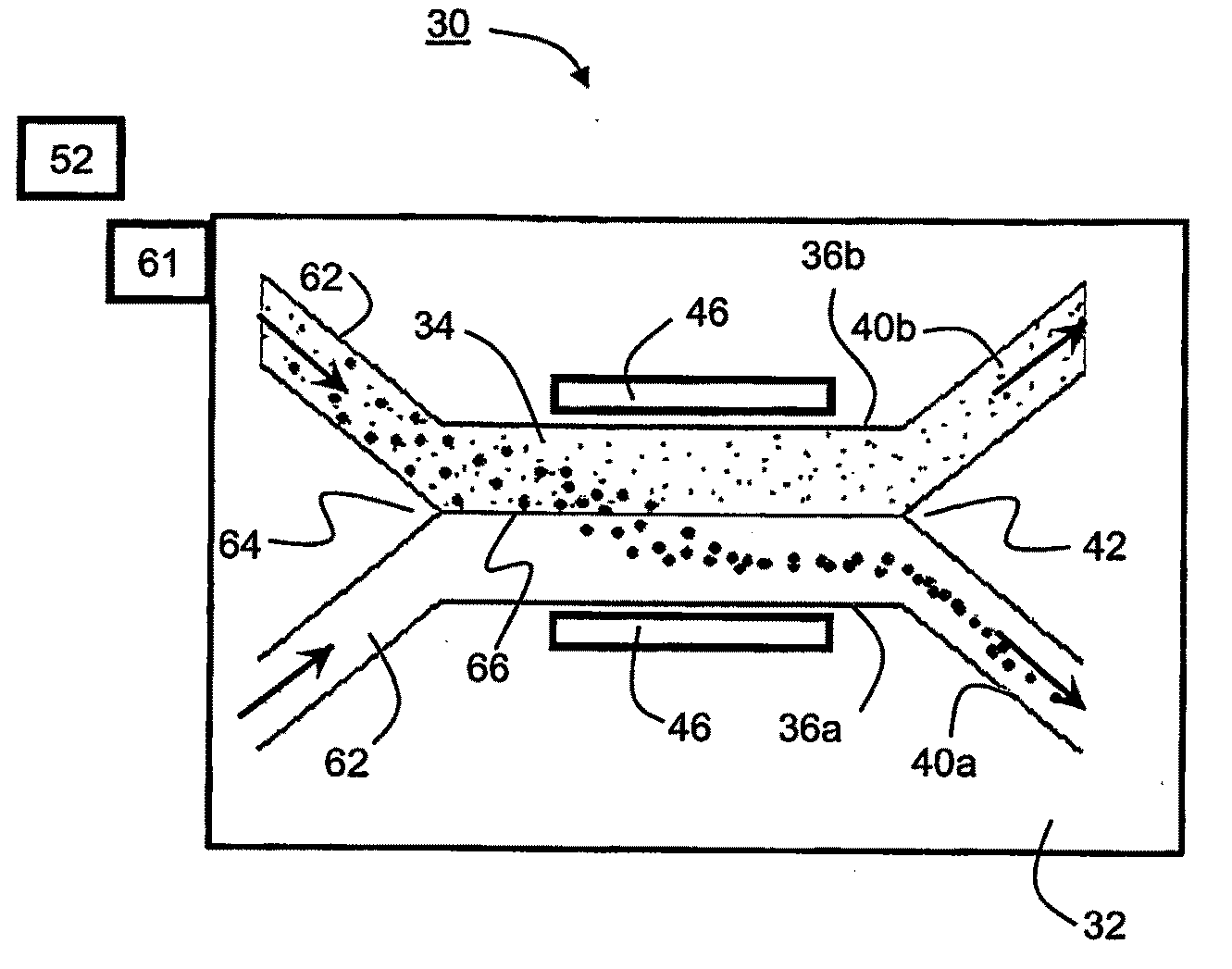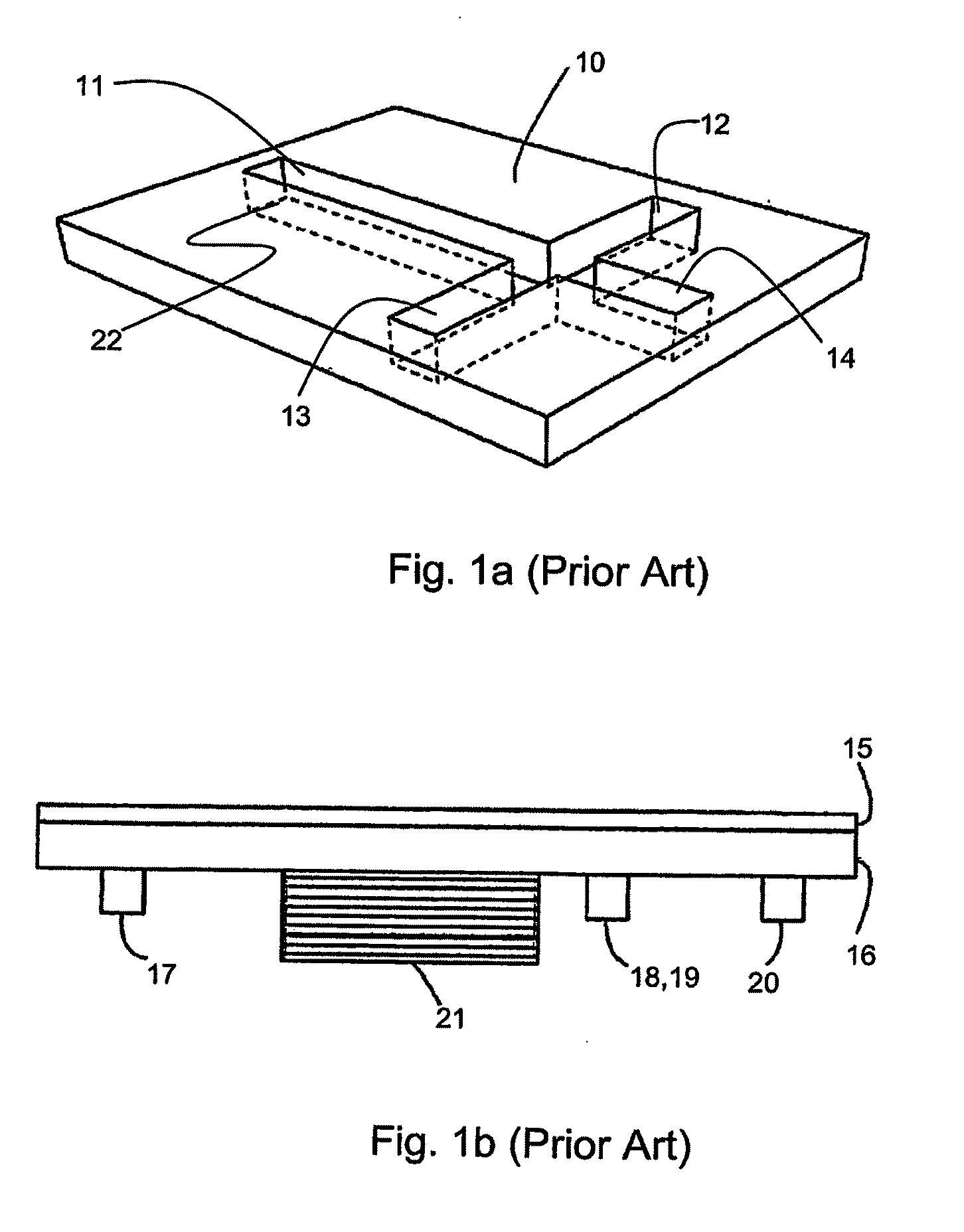Device and Method For Particle Manipulation in Fluid
a technology of fluid medium and device, applied in the direction of filtration separation, separation process, laboratory glassware, etc., can solve the problems of not being able to recover particles from filters, being highly sensitive to perturbations, and not having widespread technological applications
- Summary
- Abstract
- Description
- Claims
- Application Information
AI Technical Summary
Benefits of technology
Problems solved by technology
Method used
Image
Examples
example 1
Numerical Simulations
[0112]The present example provides a mathematical model for describing the dynamics of a particle in a channel flow. The equation of motion for a particle in a viscous medium carrying an ultrasonic standing wave can be written as:
mÿ=Fst sin(2ky)−C{dot over (y)}, (EQ. 5)
where m is the particle mass, C=6πηR is the Stokes coefficient, Fst is the amplitude of the ultrasonic force, and y is the coordinate across the channel. The dots above the coordinate y commonly represent a time-derivative, as known in the art. The relation between the ultrasonic force and energy density is given by (see also Equations 1 and 2 above):
Fst=4πkR3ĒstΦ(Λ,σ). (EQ. 6)
[0113]Equation 5 was solved numerically using the values of Fst=2.5×10−6 dyn and C=0.94×10−4 g / s, corresponding to R=5 μm, k=209.4 cm−1, Ēst=35 erg / cm3, Φ=0.22 and η=1 centistoke. As stated, the fitting parameter β was introduced to account for energy loses.
[0114]FIG. 6 shows the obtained trajectories of the particles in t...
example 2
Prototype Device
[0120]Prototype devices were manufactured and tested according to various exemplary embodiments of the present invention. Three prototypes designs were manufactured, two for particle separation and one for size sorting. The prototype devices for particle separation are schematically illustrated in FIGS. 2a-b (“one-stage” device) and FIG. 3 (“three-stage” device), and the prototype device for size sorting is schematically illustrated in FIG. 5.
Materials and Methods
[0121]Molds for microchannels were produced by a soft lithography technology using UV-sensitive epoxy (SU-8). A microfluidic chip was made of a silicone elastomer Sylgard 184 (specific gravity 1.05 gr / cm3 at 25° C., linear thermal expansion coefficient is 3·104 cm / cm per ° C.) with curing time of 4 hours at 65° C.
[0122]The cross-sectional dimensions of the microchannel for particle and erythrocytes separation were 160 μm (about half the sound wavelength, λ) in width and 150 μm in depth. The dimensions of the...
experiment 1
Continuous Particle Separation
[0140]Clearance coefficient K(Q) measurements for the 5 μm particles were preceded by measurements of particle trajectories for different initial locations, from which the value of the β parameter (quantifying the correction for the theoretical acoustic energy density) was determined. Good agreement between the measurements and the simulations were obtained for β=0.2 (see FIG. 6 in Example 1 hereinabove).
[0141]FIG. 9 shows the clearance coefficient K(Q) as a function of the fluid discharge obtained experimentally for the 6 different volume concentrations of the 5 μm particles. The results shown in FIG. 9 are generally of the same type as the numerical simulations (see FIG. 7). There are two main reasons for the differences in absolute values of K for the different concentrations. Firstly, the absolute values of K for the 0.33% concentration are smaller then those for higher concentrations up to 7.5% due to casual particles located outside the velocity a...
PUM
| Property | Measurement | Unit |
|---|---|---|
| Flow rate | aaaaa | aaaaa |
| Size | aaaaa | aaaaa |
| Width | aaaaa | aaaaa |
Abstract
Description
Claims
Application Information
 Login to View More
Login to View More - R&D
- Intellectual Property
- Life Sciences
- Materials
- Tech Scout
- Unparalleled Data Quality
- Higher Quality Content
- 60% Fewer Hallucinations
Browse by: Latest US Patents, China's latest patents, Technical Efficacy Thesaurus, Application Domain, Technology Topic, Popular Technical Reports.
© 2025 PatSnap. All rights reserved.Legal|Privacy policy|Modern Slavery Act Transparency Statement|Sitemap|About US| Contact US: help@patsnap.com



